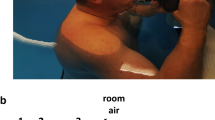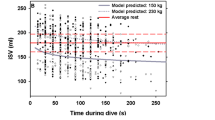Abstract
MEN are exposed to high pressures in a number of circumstances. They may be working in compressed air in a caisson or diving–bell, working under water in a diving dress, or attempting to escape from a sunken submarine. In the latter case it is obviously necessary that the air pressure inside a part of the ship should be equal to that of the water outside before a man emerges. This can be achieved either by flooding a small escape chamber holding only two men, or a whole compartment of the ship. Men have escaped by both these methods. They can rise through the water either holding their breath or breathing from a Davis submarine escape apparatus. The former method is not to be recommended, but it is not quite so hazardous as it sounds, for a lung–full of air at 5 atmospheres contains as much oxygen as a lung–full of oxygen at atmospheric pressure, and will allow a man to hold his breath for more than twice the normal time. The Davis submarine escape apparatus consists of a rubber bag and a soda–lime canister to absorb carbon dioxide. The bag is filled with oxygen from a small cylinder of the compressed gas. It has the advantage over air that it can be used almost to the last dreg. We shall come to its disadvantages later.
This is a preview of subscription content, access via your institution
Access options
Subscribe to this journal
Receive 51 print issues and online access
$199.00 per year
only $3.90 per issue
Buy this article
- Purchase on Springer Link
- Instant access to full article PDF
Prices may be subject to local taxes which are calculated during checkout
Similar content being viewed by others
References
Haldane, J. B. S., and Priestley, J. G., "Respiration" (Oxford, 1935).
Behnke, A. R., Thomson, R. M., and Motley, E. P., "Psychologic effects of breathing air at 4 atmospheres' pressure", Amer. J. Physiol., 112, 554 (1935).
Behnke, A. R., and Yarbrough, O. D., "Respiratory resistance, oil-water solubility, and mental effects of argon, compared with helium and nitrogen", Amer. J. Physiol., 126, 409 (1939).
Bert, Paul, "La Pression barométrique" (Paris, 1878).
Behnke, A. R., Johnson, F. S., Poppen, J. R., and Motley, E. P., "The effect of oxygen on man at pressures from 1 to 4 atmospheres", Amer. J. Physiol., 110, 565 (1935).
Haldane, J. S., and Smith, J. L., "Physiological etfects of air vitiated by respiration", J. Path. Bact., 1, 168 (1899).
Alexander, W., Duff, P., Haldane, J.B.S., Ives, G., and Renton, D., "After-effects of exposure of men to carbon dioxide", Lancet, 419 (Aug. 19, 1939).
Davis, R., "Deep diving and submarine operations" (London, 1935).
Rights and permissions
About this article
Cite this article
HALDANE, J. HUMAN LIFE AND DEATH AT HIGH PRESSURES. Nature 148, 458–460 (1941). https://doi.org/10.1038/148458a0
Issue Date:
DOI: https://doi.org/10.1038/148458a0
This article is cited by
-
Argon gas: a potential neuroprotectant and promising medical therapy
Medical Gas Research (2014)
-
Warum wirkt Sauerstoffüberdruck rasch tödlich?
Zeitschrift für Die Gesamte Experimentelle Medizin (1950)
Comments
By submitting a comment you agree to abide by our Terms and Community Guidelines. If you find something abusive or that does not comply with our terms or guidelines please flag it as inappropriate.



